
Swan upping is an annual ceremony in England in which mute swans on the River Thames are rounded up, caught, ringed, and then released.

Swan upping is an annual ceremony in England in which mute swans on the River Thames are rounded up, caught, ringed, and then released.
By prerogative right, the British Crown enjoys ownership of all unmarked mute swans in open water. Rights over swans may, however, be granted to a British subject by the Crown (accordingly they may also be claimed by prescription). [1] Until the 16th century, the ownership of swans in a given body of water was commonly granted to landowners. The only bodies who still exercise such rights are two livery companies of the City of London, the Worshipful Company of Vintners and the Worshipful Company of Dyers, who thus share equally with the Crown in the number of swans in the Thames that they own. The tradition of swan upping on the Thames began in the 12th century. [2] [3]
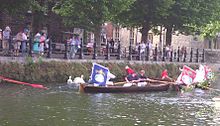
Swan upping is the traditional means by which the swans on the Thames are apportioned among the three proprietors. Its main practical purposes today are to conduct a census of swans and check their health. It occurs annually in the third week of July. Over five days, the Crown's, the Vintners' and the Dyers' respective 'swan uppers' row up the river in skiffs (in recent centuries from Sunbury to Abingdon). [4] [5] [6]
The Crown's swans are recorded by the Marker of the Swans, who is rowed in a skiff by oarsmen from the Company of Watermen and Lightermen. [7] The Crown's swan uppers, who wear distinctive red uniforms, catch the swans, weigh and measure the cygnets, and check them for injuries. [4] [8] [9]
Based on their parentage, cygnets are determined to belong to the Crown, the Dyers or the Vintners. [4] Swans belonging to the Crown are left unmarked, except for a lightweight ring linked to the database of the British Trust for Ornithology.[ citation needed ] Those belonging to the Dyers and Vintners receive a similar ring on the other leg.[ citation needed ] The rings have replaced nicks on the swans' bills, which used to be made with a metal implement, one nick for the Dyers and one on each side for the Vintners. [9] The former practice is reflected in The Swan with Two Necks , the name of a former pub in the City connected with the Vintners, which was a corruption of "The Swan with Two Nicks".[ citation needed ]
| Seigneur of the Swans | |
|---|---|
| | |
| Type | Position held by the British Monarch |
| Formation | c. 12th Century |
Seigneur of the Swans is a title of the British Monarch in regards to swan upping in England. The title which has stood for centuries and reflects the monarchs prerogative of ownership of all unmarked mute swans in open water. [10]
The present holder is King Charles III.
They have two officers charged with carrying out this responsibility on behalf of them, the Warden of the Swans and the Marker of the Swans both are offices of the royal household, before 1993 both positions were one position of the Keeper of the King's/Queen's Swans. [11]
The Marker of the Swans and Kings swan uppers, all wear the Royal Cypher of the current Monarch on their uniform. [12]
On 20 July 2009, Queen Elizabeth II, as Seigneur of the Swans, attended the Swan Upping ceremony, the first time a reigning monarch had personally attended. [9]
In 2012, exceptional high river flows for summer prompted a partial cancellation: between Sunbury and Windsor, the first time the tradition is known to have been cancelled (albeit partially). [3]
The first known full cancellation took place in 2020 due to COVID-19 social distancing measures. [13]
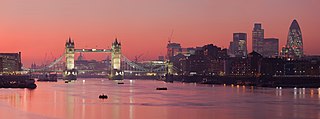
The River Thames, known alternatively in parts as the River Isis, is a river that flows through southern England including London. At 215 miles (346 km), it is the longest river entirely in England and the second-longest in the United Kingdom, after the River Severn.

Swans are birds of the genus Cygnus within the family Anatidae. The swans' closest relatives include the geese and ducks. Swans are grouped with the closely related geese in the subfamily Anserinae where they form the tribe Cygnini. Sometimes, they are considered a distinct subfamily, Cygninae.

Maidenhead is a market town in the Royal Borough of Windsor and Maidenhead in the county of Berkshire, England. It lies on the southwestern bank of the River Thames, which at this point forms the border with Buckinghamshire. In the 2021 Census, the Maidenhead built-up area had a population of 67,375. The town is 27 miles (43 km) west of Charing Cross, London and 13 miles (21 km) east-northeast of Reading.

Southwark Bridge is an arch bridge in London, for traffic linking the district of Southwark and the City across the River Thames. Besides when others are closed for temporary repairs, it has the least traffic of the Thames bridges in London.

The Worshipful Company of Vintners, one of the Great Twelve City Livery Companies, retains close links with the wine trade.
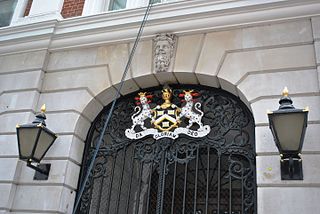
The Worshipful Company of Dyers is one of the Livery Companies of the City of London. The Dyers' Guild existed in the twelfth century; it received a Royal Charter in 1471. It originated as a trade association for members of the dyeing industry but is now mainly a charitable institution. Each year the company participates in the ceremony of Swan Upping along the River Thames.

The Crown Jewels of the United Kingdom, originally the Crown Jewels of England, are a collection of royal ceremonial objects kept in the Jewel House at the Tower of London, which include the coronation regalia and vestments worn by British monarchs.

Sunbury-on-Thames, known locally as Sunbury, is a town on the north bank of the River Thames in the Borough of Spelthorne, Surrey, England, 13 mi (21 km) southwest of central London. Historically part of the county of Middlesex, in 1965 Sunbury and other surrounding towns were initially intended to form part of the newly created county of Greater London, but were instead transferred to Surrey. Sunbury adjoins Feltham to the north, Hampton to the east, Ashford to the northwest and Shepperton to the southwest. Walton-on-Thames is to the south, on the opposite bank of the Thames.
The Company of Watermen and Lightermen (CWL) is a historic City guild in the City of London. However, unlike the city's 111 livery companies, CWL does not have a grant of livery. Its meeting rooms are at Waterman's Hall on St Mary at Hill, London.

Teddington Lock is a complex of three locks and a weir on the River Thames between Ham and Teddington in the London Borough of Richmond upon Thames, England. Historically in Middlesex, it was first built in 1810.

The Coronet of Charles, Prince of Wales is a small crown that is part of the Honours of Wales. The gold coronet, with diamonds set in platinum, was made for and used by King Charles III at his investiture as Prince of Wales in 1969. Designed by the artist Louis Osman, the coronet was a gift from the Worshipful Company of Goldsmiths to the Prince's mother, Queen Elizabeth II. It has been described as modern but its form is traditional. The coronet is on permanent display in the Jewel House at the Tower of London.
The Keeper of the King's/Queen's Swans was a late medieval-founded office in the Royal Household of the Sovereign of England, later Great Britain and ultimately the United Kingdom. He was earlier called the King's/Queen's Swanmaster. The office existed to perform Swan-Upping marking and health-checking carried out using Thames skiffs on many of the non-tidal reaches of the River Thames in latter years from Sunbury-on-Thames passing Windsor, Berkshire to Henley on Thames. In 1993 it was replaced by two separate offices: Warden of the Swans and Marker of the Swans.
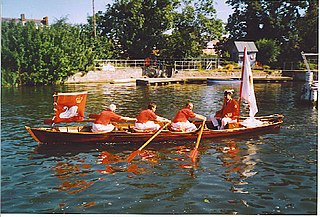
Marker of the Swans, or Swan Marker, is an office in the Royal Household of the Sovereign of the United Kingdom.

Molesey Lock is a lock on the River Thames in England at East Molesey, Surrey on the right bank.
The Thames is one of the main rowing rivers in Europe. Several annual competitions are held along its course, including the Henley Royal Regatta, The Boat Race and other long-distance events, called Head of the River races (Heads).
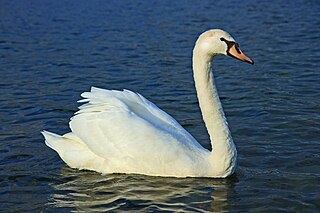
The mute swan is a species of swan and a member of the waterfowl family Anatidae. It is native to much of Eurasia, and the far north of Africa. It is an introduced species in North America, home to the largest populations outside of its native range, with additional smaller introductions in Australasia and southern Africa. The name "mute" derives from it being less vocal than other swan species. Measuring 125 to 160 cm in length, this large swan is wholly white in plumage with an orange beak bordered with black. It is recognisable by its pronounced knob atop the beak, which is larger in males.

Swan Lifeline is the oldest registered charity devoted entirely to the care of sick and injured swans in the Thames Valley and surrounding areas, It is a non-profit organization dedicated to the rescue, rehabilitation and release of swans and other non-alien waterfowl. Founded in 1986, it has been actively involved in educating the public about the incidence and effects of pollution and human activities on swans and other wildfowl on the UK's rivers and waterways.

The Swan Sanctuary, Shepperton is a wildlife hospital dedicated to the treatment, care and rehabilitation of swans and wildfowl in the UK and is situated close to the village of Shepperton in area of Middlesex, England. The Swan Sanctuary is registered with the Royal College of Veterinary Surgeons as Veterinary Premises No. 7002114 – Sally Goulden, B. Vet. Med., Cert. G.P. (SAM), MRCVS

Swan marks in England were a variety of unique identifying notches made on the beaks of swans living and foraging at large on rivers, and elsewhere, in order to identify their official "owner" or keeper. Swans were royal birds, the property of the monarch, but ownership of flocks could be granted by royal deed to certain individuals, whose birds would then be marked with the appointed swan mark. The marks were designed and granted by signed and sealed deed by the "Master of his/her Majesty's Royal Game of all manner of swans and cygnets" for the county concerned. All unmarked swans on English rivers continue to be the property of the monarch, and the royal office of Marker of the Swans survives.